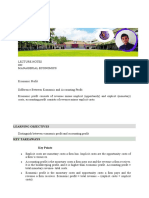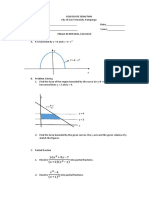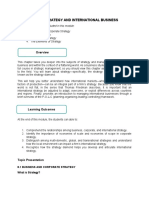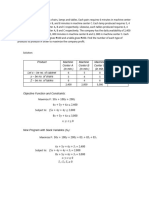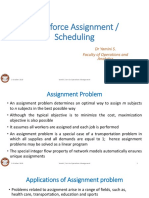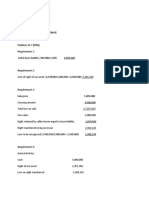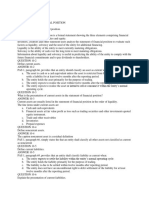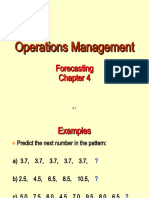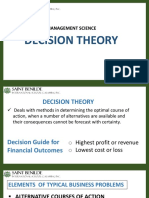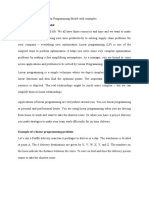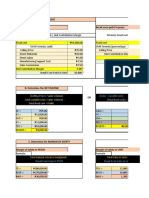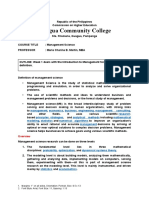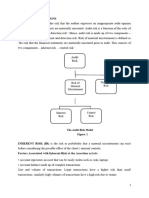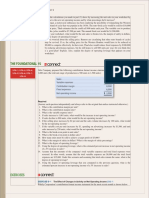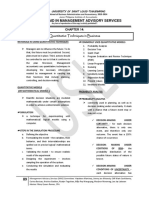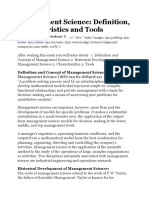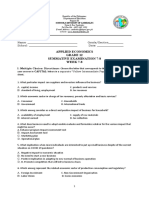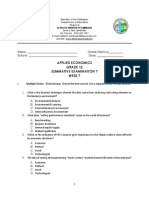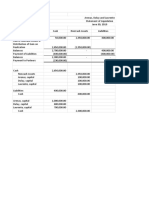Chapter 2: Introduction to Management Science
Intended Learning Outcomes: After studying this chapter, you should be able to do the
following
a. Describe the nature and concept of management science
b. Identify the fields that management science involves in
c. Explain the characteristics of management science
d. Recognize the historical development of management science
e. Discuss various applications of management science
f. Deliberate the decision making process
g. Analyze the phase of decision making process
h. Explicate the process of quantitative analysis
MANAGEMENT SCIENCE (MS) is the broad interdisciplinary study of problem solving and
decision making in human organizations, with strong links to management, economics,
business, engineering, management consulting, and other fields.
Management Science (MS) can be defined as: “A problem-solving process used by an
interdisciplinary team to develop mathematical models that represent simple-to-complex
functional relationships and provide management with a basis for decision-making and a
means of uncovering new problems for quantitative analysis”.
It uses various scientific research-based principles, strategies, and analytical methods
including mathematical modeling, statistics and numerical algorithms to improve an
organization's ability to enact rational and accurate management decisions by arriving at
optimal or near optimal solutions to complex decision problems. Management science
helps businesses to achieve goals using various scientific methods.
Some of the fields that management science involves include: Data mining, Decision
analysis,
Engineering, Forecasting, Game theory, Industrial engineering, Logistics, Mathematical
modeling, Optimization, Probability and statistics, Project management, Psychology,
Simulation, Social network / Transportation forecasting models, Sociology, Supply chain
management, Management consulting, as well as many others.
Historical Development of Management Science:
The roots of management science extend to the work of F.W. Taylor, the father of Scientific
Management. Taylor is known for his systematic development of management techniques
which he started at the Midvale Steel Company in Philadelphia around 1880. Taylor
developed what he called his four principles of management: Research, Standardization,
Control and Cooperation.
When installed at the Link Belt Engineering Company in 1905, the system included cost
accounting, time study, inventory control, production control, planning, output scheduling,
functional operation, standardized procedures, a mnemonic system of classification, and
means for maintaining quality production.
Associated with Taylor were other important pioneers of scientific management – Carl
Barth, Gantt, Thompson, Hathaway and many others. Barth brought to the work of scientific
management the use of research mathematics, which he merged with his extensive
�knowledge of machine tools. Gantt contributed the recognition of worker psychology, the
development of a bonus plan, and the charts used in production scheduling.
Out of this came the term Industrial Engineering which today is descriptive of the work of
functional staffs responsible for such activities as incentive standards, methods analysis,
quality control, production control, cost control and materials handling.
During the ten years just after World War II, a great deal of management science was
performed under the name of operations research. The influx of physical scientists many of
whom were unacquainted with modern management administration into war technology
and the pressures of total war with new and terrible weapons gave rise to a rediscovery of
a kind of pragmatic scientific management. This merged with an increasingly popular
acceptance of statistical quality control in America and the practical development of high-
speed electronic calculators to give impetus to the operations-research approach.
In brief, management science describes an integrated approach to operational control
based on the application of scientific research methods to business problems. A systematic
approach to problem solving received early impetus from Taylor’s scientific management
movement and is continued today by Industrial engineers and mathematical business
analysts. This approach is characterized by a methodology of sequential investigation steps.
Characteristics of Management Science
The four major characteristics of management science are as follow:
1. Examine Functional Relationships from a Systems Overview - The activity of any one
function of a company will have some effect on the activity of each of the other
functions. Therefore, it is necessary to identify all important interactions and determine
their impact on the company as a whole. Initially, the functional relationships in a
management science project are expanded deliberately so that all the significantly
interacting parts and their related components are contained in a statement of the
problem. A systems overview examines the entire area under the manager’s control.
This approach provides a basis for initiating inquiries into problems that seem to be
affecting performance at all levels.
2. Use the Interdisciplinary Approach - Management science makes good use of a simple
principle, it looks at the problem from different angles and approaches. For example, a
mathematician might look at the inventory problem and formulate some type of
mathematical relationships between the manufacturing departments and customer
demand. A chemical engineer might look at the same problem and formulate it in terms
of flow theory. A cost accountant might conceive the inventory problem in terms of
component costs (e.g., direct material cost, direct labor cost, overheads etc.) and how
such costs can be controlled and reduced, etc. Therefore, management science
emphasizes over the interdisciplinary approach because each of the individual aspects
of a problem can be best understood and solved by those, experts in different fields
such as accounting, biological, economic, engineering, mathematics, physical,
psychological, sociological, statistical etc.
3. Uncover New Problems for Study - The third characteristic of management science,
which is often overlooked, is that the solution of an MS problem brings new problems
to light. All interrelated problems uncovered by the MS approach do not have to be
solved at the same time. However, each must be solved with consideration for other
problems if maximum benefits are to be obtained.
�4. Use a Modeling-Process Approach to Problem Solving - Management science takes a
systematic approach to problem solving. It may use a modeling process approach taking
the help of mathematical models.
Other Characteristics of Management Science are:
5. A primary focus on managerial decision-making.
6. The application of science to decision-making.
7. A dependence on electronic computers.
8. An appraisal resting on criteria of economic effectiveness. Effectiveness may be defined
as the extent to which goals are achieved. Effectiveness is evaluated by measures of
effectiveness (also known as measures of performance).
Applications of management science are abundant in industries such as airlines,
manufacturing companies, service organizations, military branches, and in government. The
following list presents typical managerial problems where management science techniques
could be applied: Inventory control, Facility design, Product-mix determination, Portfolio
analysis, Scheduling and sequencing, Merger-growth analysis, Transportation planning,
Design of information systems, Allocation of scarce resources, Investment decisions (new
plants, etc.), Project management – planning and control, New product decisions Sales force
decisions, Market research decisions etc. For solving these and many other problems the
following techniques can be used:
a. Decision Analysis - These techniques can be used to select optimal strategies out of
several decision alternatives. Managerial problems and appropriate tools are divided,
according to the kind of manager’s information, into three classes: decisions under
certainty (deterministic), decision under risk (probabilistic) and decisions under
uncertainty.
b. Forecasting - Forecasting methods support the manager’s prediction of future aspects
of a business operation. Statistics and econometrics offer many techniques based on
time-series and regression analysis. The main managerial goal is to project future trends
following the previous behavior of the system. The well-known are the methods of
Moving Averages, Least Squares, and Exponential Smoothing.
c. Project Management - In many situations the managers are responsible for planning,
scheduling and controlling projects that consist of many separate jobs or tasks
performed by a variety of departments or individuals. An execution of each job takes
specific time. There are two basic methods for solving those problems: CPM (Critical
Path Method) and PERT (Program Evaluation Review Technique). Both methods require
the network representation of the problem.
d. Linear Programming - It is one of the best-known tools of management science. This
approach mostly defines the problem as the maximizing (minimizing) a linear function,
respecting the set of linear constraints.
e. Inventory Models - Inventory control is one of the most popular techniques, which
helps managers to determine when and how much to order. The main goal is usually to
find a proper balance between the inventory holding cost and the cost of executing an
order.
f. Distribution Models - A distribution problem is a special type of linear programming
problem. There are two main types of distribution problems: The Transportation
Problem and the Assignment
� Problem. The transportation problem deals with shipments from a number of sources to a
number of destinations, whereas the assignment problem deals with finding the best one-
to-one match for each of a given number of possible “candidates” to a number of
proposed “positions”.
g. Network Models - Some problems can be described graphically as a network (the set of
nodes and arcs). Typical situation is a transportation network: cities (nodes) are
connected to each other by roads (arcs). If we evaluate the network (in this case we are
interested e.g. in distances between all the cities), the task is often to find the minimal
distance from one city to all other cities.
h. Markov Analysis - This technique can be used to describe the behavior of a system in a
dynamic situation (evolution of the system throughout the time). If - at a given time
point - the system is in one of possible states, at following time point the system can
remain in current state or can move into any other state. Remaining in current state or
movement to another state are set by transition probabilities. The manager can be
interested in the probability with which the system will be in the specific state at the
specific time. Markov analysis is a very powerful tool of management science with many
real applications.
i. Theory of Games - This area is an extension of decision analysis to the situations with
two or more decision makers. Simultaneous decisions (selected strategies) of all
managers initiate an action that affects all decision makers (players), i.e. their profit,
cost, etc. In some conflicts, there is a possibility for two or more decision makers to
cooperate, while competing with the others. In economic theory we can find a typical
case of strategic game - oligopoly model.
j. Goal Programming - When several competing objectives have to be considered
simultaneously, more powerful tool is needed. Goal programming is a special technique
for dealing with such cases, usually within the framework of linear programming.
Decision Making Process
Decision making is the process of making choices by identifying a decision, gathering
information, and assessing alternative resolutions. Using a step-by-step decision-making
process can help you make more deliberate, thoughtful decisions by organizing relevant
information and defining alternatives. This approach increases the chances that you will
choose the most satisfying alternative possible.
1. Identify the decision You realize that you need to make a decision. Try to clearly
define the nature of the decision you must make. This first step is very important.
2. Gather relevant information Collect some pertinent information before you make
your decision: what information is needed, the best sources of information, and
how to get it. This step involves both internal and external “work.” Some
information is internal: you’ll seek it through a process of self-assessment. Other
information is external: you’ll find it online, in books, from other people, and from
other sources.
3. Identify the alternatives As you collect information, you will probably identify
several possible paths of action, or alternatives. You can also use your imagination
and additional information to construct new alternatives. In this step, you will list
all possible and desirable alternatives.
4. Weigh the evidence Draw on your information and emotions to imagine what it
would be like if you carried out each of the alternatives to the end. Evaluate
� whether the need identified in Step 1 would be met or resolved through the use of
each alternative. As you go through this difficult internal process, you’ll begin to
favor certain alternatives: those that seem to have a higher potential for reaching
your goal. Finally, place the alternatives in a priority order, based upon your own
value system.
5. Choose among alternatives Once you have weighed all the evidence, you are ready
to select the alternative that seems to be the best one for you. You may even
choose a combination of alternatives. Your choice in Step 5 may very likely be the
same or similar to the alternative you placed at the top of your list at the end of
Step 4.
6. Take action You’re now ready to take some positive action by beginning to
implement the alternative you chose in Step 5.
7. Review your decision & its consequences In this final step, consider the results of
your decision and evaluate whether or not it has resolved the need you identified
in Step 1. If the decision has not met the identified need, you may want to repeat
certain steps of the process to make a new decision. For example, you might want
to gather more detailed or somewhat different information or explore additional
alternatives.
Analysis Phase of Decision Making Process
A. Qualitative Analysis – based largely on the manager’s judgment and experience;
includes the manager’s intuitive feel for the problem; and is more of an art than a
science.
B. Quantitative Analysis – analyst will concentrate on the quantitative facts or data
associated with the problem, will develop mathematical expressions that describe
the objective, constraints, and other relationship that exists in the problem, and
will use one or more quantitative methods to make a recommendation.
Potential reasons for a Quantitative analysis approach to decision making
b.1. The problem is complex b.2. The problem is very important
b.3. The problem is new b.4. The problem is repetitive
Process of Quantitative Analysis




